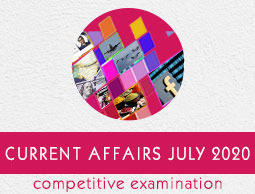
- Appointments
- Awards
- Bills & Acts
- Books & Authors
- Committees
- Deaths
- Defence
- Economic
- Environment
- Finance
- Important Days
- International
- Miscellaneous
- National
- Persons in News
- Places in News
- Regional
- Reports
- Resignations
- Science & Technology
- Sports
- National Education Policy 2020
- July 2020 - Exams Resources
- Current Affairs - Quiz
- Current Affairs - Test
- Current Affairs - PDF
National Education Policy 2020

The Union Cabinet cleared a new National Education Policy (NEP). The latest policy id India's third and replaces the 1986 NEP. The NEP 2020 aims at making India a global knowledge superpower. The Ministry of Human Resource Development would be renamed as Ministry of Education.
The key highlights can be broadly classified into two groups - School Education and Higher Education.
A) School Education:
Universalization of education from preschool to secondary level with 100% Gross Enrolment Ratio (GER) in school education by 2030.
About 2 crores out of school children will be brought back into mainstream under NEP 2020.
The current 10+2 system to be replaced by a new 5+3+3+4 curricular structure corresponding to ages 3-8, 8-11, 11-14, and 14-18 years respectively. This will bring the hitherto uncovered age group of 3-6 years under the school curriculum, which has been recognised globally as the crucial stage for the development of mental faculties of a child.
It will also have 12 years of schooling with three years of Anganwadi/ pre schooling.
NCERT will develop a National Curricular and Pedagogical Framework for Early Childhood Care and Education (NCPFECCE) for children up to the age of 8.
Vocational Education to start from Class 6 with Internships.
Teaching up to at least Grade 5 to be in mother tongue/regional language.
A new and comprehensive National Curriculum Framework for Teacher Education (NCFTE) 2021, will be formulated by the National Council for Teacher Education (NCTE) in consultation with National Council of Educational Research and Training (NCERT).
By 2030, the minimum degree qualification for teaching will be a 4-year integrated B.Ed. degree.
A new National Assessment Centre, PARAKH (Performance Assessment, Review, and Analysis of Knowledge for Holistic Development), will be set up as a standard-setting body.
B) Higher Education:
NEP 2020 aims to increase the Gross Enrolment Ratio in higher education including vocational education from 26.3% (2018) to 50% by 2035.
3.5 crore seats to be added in higher education.
It proposes a holistic Undergraduate education with a flexible curriculum which can be of 3 or 4 years with multiple exit options and appropriate certification within this period.
Multidisciplinary Education and Research Universities (MERUs), at par with IITs, IIMs, to be set up as models of best multidisciplinary education of global standards in the country.
The National Research Foundation will be created as an apex body for fostering a strong research culture and building research capacity across higher education.
Higher Education Commission of India (HECI) will be set up as a single overarching umbrella body for entire higher education, excluding medical and legal education. HECI will have four independent verticals namely - National Higher education regulatory council (NHERC) for regulation, General Education Council (GEC) for standard-setting, Higher education Grants council for funding and National Accreditation Council for accreditation.
It also paves the way for foreign universities to set up campuses in India.
The policy aims to achieve 100% youth and adult literacy.
Academic Bank of Credits to be established to facilitate Transfer of Credits.
The central government and state governments will work together to increase the public investment in the education sector to reach 6% of GDP at the earliest.